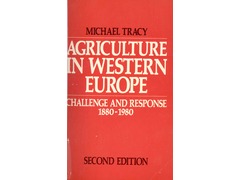Scandinavia
Documents from [1660] to [1939]Identity Statement
2 files
Carr, Mary
Content and Structure
The Scandinavian countries traditionally had a free peasantry. Norway and Sweden in particualr where livestock predominated was not traditionally characterised by village settlements. The situation was different in Denmark which had village settlement and open-field cultivation. After 1660 Danish peasants lost their freedom, while their counterparts in Norway and Sweden didn't.
By 1815 most of Denmark's open fields had been enclosed, due to a series of reforms which meant that peasants could buy out their holdings, this created effectively democracy in Denmark this coupled with a system advocating rural education led to greater agricultural expertise and so the Danish farmer was better able to cope with the crisis that followed during the 1880's. Instead of supporting the price of grain through import duties farmers transformed their agriculture from arable to livestock production and so exports of livestock products increased dramaticaly. The development of co-operation was another predominant feature in Danish farming, the crisis of the 1880's accelerated this movement from just credit associations to co-operative processing, distribution and marketing such as the creation of co-operative dairies. Such a transformation enabled Denmark to profit from the crisis by producing food-stuffs that were in high demand. Thereby Denmark entered the twentieth century as an efficient an structured export country.
Denmark didn't really feel the crisis in agriculture, as a result of the war and the economic crisis that hit Europe in the late 1920's, until later than other European countries as during the war she was neutral and thus was able to continue exporting to Britain and Germany, it wasn't until 1931 that Denmark's agriculture felt the pinch. Danish agriculture was dependent on trade this made import restrictions impractical and since her problems resulted from protectionist measures in other countries, Denmark sought better conditions for exports to the countries with the largest markets, Britain and Germany. The Danish Exchange Control Office was established, whereby all imports had to be authorised by this office. In June 1933 the Anglo- Danish commercial treaty was signed. A bilateral agreement in March 1934 between Germany and Denmark stated that the two countries would endeavour to promote trade between them and to settle difficulties by negotiation. This period saw further intervention by the Government in the domestic market. A marketing quota system was introduced. There was a system of compensation using a system of guaranteed minimum prices for grains and in 1938 owing to a renewed fall in world grain prices, imports of wheat and rye were suspended compeletely.
Tariffs were used in the Scandinavian countries, which although traditionally favoured free-trade, endorsed the use of tariffs at times of economic distress. Other non-tariff measures were also used, Norway invented the "milling ratio", which was later adopted by Sweden and Denmark.
Conditions of Access and Use
Allied Materials
Notes
See Michael Tracy's book: Government and Agriculture in Western Europe 1880-1988, 3rd ed. (1989)
